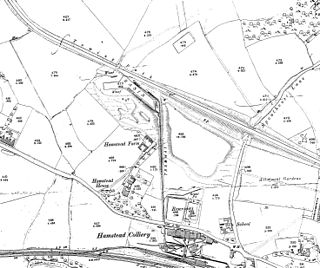Related Research Articles

North Warwickshire is a local government district with borough status in the ceremonial county of Warwickshire, West Midlands, England. Outlying settlements in the borough include the two towns of Atherstone and Coleshill. Notable villages in the borough include Dordon, Polesworth, Kingsbury, Water Orton and Shustoke.
A mining accident is an accident that occurs during the process of mining minerals or metals. Thousands of miners die from mining accidents each year, especially from underground coal mining, although accidents also occur in hard rock mining. Coal mining is considered much more hazardous than hard rock mining due to flat-lying rock strata, generally incompetent rock, the presence of methane gas, and coal dust. Most of the deaths these days occur in developing countries, and rural parts of developed countries where safety measures are not practiced as fully. A mining disaster is an incident where there are five or more fatalities.
Glace Bay is a community in the eastern part of the Cape Breton Regional Municipality in Nova Scotia, Canada. It forms part of the general area referred to as Industrial Cape Breton.
Cumberland is an incorporated village municipality east of Perseverance Creek, near the east coast of central Vancouver Island, British Columbia. The Comox Valley community is west of BC Highway 19 and is by road about 105 kilometres (65 mi) northwest of Nanaimo and 10 kilometres (6 mi) southwest of Courtenay.

Arley is a civil parish in the North Warwickshire district of Warwickshire, England. The parish includes two settlements, New Arley and Old Arley. Old Arley is to the west of the Bourne Brook and the Birmingham to Peterborough Line, and New Arley is to the east. Nearby places are Ansley and Astley. Old Arley contains the medieval church of St Wilfred's, and a nearby Methodist church. New Arley contains St Michael's Church of England and St Joseph's Catholic Church. The two Anglican churches form one ecclesiastical parish, and St Joseph's is run from St Anne's.
The Kent Coalfield was a coalfield in the eastern part of the English county of Kent. The Coalfields Trust defines the Kent Coalfield as the wards of Barham Downs and Marshside in the Canterbury district, and the wards of Aylesham, Eastry, Eythorne & Shepherdswell, Middle Deal & Sholden, Mill Hill and North Deal in the Dover district.

Eckley Miners' Village in eastern Pennsylvania is an anthracite coal mining patch town located in Foster Township, Pennsylvania. Since 1970, Eckley has been owned and operated as a museum by the Pennsylvania Historical and Museum Commission.

Whitsett is an unincorporated community in Fayette County, Pennsylvania, United States, about 30 miles (50 km) south of Pittsburgh population is around 200. It was founded in 1845 by Ralph C. Whitsett Sr. He and his family built a large red brick house in 1873, which still stands today. The community is made up of mostly “company” houses that were built for workers that worked in a large coal mine located nearby, the mine was Banning #21. Most of the houses were ½ houses built to accommodate two families. The mine has been closed since 1954 and most of the houses have been renovated and turned into single-family dwellings.
Piccadilly is a small village in the North Warwickshire district of the county of Warwickshire in England. It is located near to the larger village of Kingsbury, and is four miles south of Tamworth.

The Cheadle Coalfield is a coalfield in the United Kingdom. Centred on the town of Cheadle, Staffordshire and its outlying villages it lies to the east of Stoke-on-Trent and the much larger North Staffordshire Coalfield. The area has been mined for many years, with documentary evidence from Croxden Abbey citing coal mining in the 13th century.
The Minnie Pit disaster was a coal mining accident that took place on 12 January 1918 in Halmer End, Staffordshire, in which 155 men and boys died. The disaster, which was caused by an explosion due to firedamp, is the worst ever recorded in the North Staffordshire Coalfield. An official investigation never established what caused the ignition of flammable gases in the pit.

Daw Mill was a coal mine located near the village of Arley, near Nuneaton, in the English county of Warwickshire. The mine was Britain's biggest coal producer. It closed in 2013 following a major fire. It was the last remaining colliery in the West Midlands.
The Avondale Colliery was a coal mine in Plymouth Township, Luzerne County, near Plymouth, Pennsylvania in the small town of Avondale. The mine was considered to be "one of the best and worst" operating in Pennsylvania's Wyoming Valley.

Hamstead Colliery in Hamstead, England, produced coal between 1878 and 1965, by mining the South Staffordshire 'Thick' coal seam. It suffered a major fire in 1908 in which 26 men died.

Coal mining in the United Kingdom dates back to Roman times and occurred in many different parts of the country. Britain's coalfields are associated with Northumberland and Durham, North and South Wales, Yorkshire, the Scottish Central Belt, Lancashire, Cumbria, the East and West Midlands and Kent. After 1972, coal mining quickly collapsed and had practically disappeared by the 21st century. The consumption of coal – mostly for electricity – fell from 157 million tonnes in 1970 to 18 million tonnes in 2016, of which 77% was imported from Colombia, Russia, and the United States. Employment in coal mines fell from a peak of 1,191,000 in 1920 to 695,000 in 1956, 247,000 in 1976, 44,000 in 1993, and to 2,000 in 2015.

Marley Hill is a former colliery village about six miles to the south west of Gateshead, near the border between Tyne and Wear and County Durham. It has been part of the Metropolitan Borough of Gateshead since 1974. Prior to this it was part of Whickham Urban District. It lies within the Whickham South & Sunniside electoral ward of the Blaydon parliamentary constituency.
The Astley and Tyldesley Collieries Company formed in 1900 owned coal mines on the Lancashire Coalfield south of the railway in Astley and Tyldesley, then in the historic county of Lancashire, England. The company became part of Manchester Collieries in 1929 and some of its collieries were nationalised in 1947.
Hapton Valley Colliery was a coal mine on the edge of Hapton near Burnley in Lancashire, England. Its first shafts were sunk in the early 1850s and it had a life of almost 130 years, surviving to be the last deep mine operating on the Burnley Coalfield.

Bentley Colliery was a coal mine in Bentley, near Doncaster in South Yorkshire, England, that operated between 1906 and 1993. In common with many other mines, it suffered disasters and accidents. The worst Bentley disaster was in 1931 when 45 miners were killed after a gas explosion. The site of the mine has been converted into a woodland.
The Prince of Wales Colliery was a coal mine that operated for over 130 years in Pontefract, West Yorkshire, England. It was permanently closed in 2002 after geological problems were found to make accessing remaining coal reserves unprofitable, and most of the site was later converted for housing.
References
- ↑ "Piccadilly Mining Heritage". Archived from the original on 12 October 2015. Retrieved 16 February 2009.
- ↑ Holley, Duncan; Chalk, Gary (1992). The Alphabet of the Saints. ACL & Polar Publishing. p. 181. ISBN 0-9514862-3-3.